|
 |
|
Cliff Weirick, AD1, USN |
Cliff Weirick - 1947
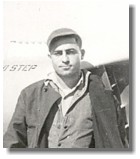 |
Aviation Machinist Mate 1st Class (AD1)
Cliff Weirick was one of three jet maintenance
men who worked for me at The Naval Air Missile Test Center at Point Mugu, California, 1947 -1949. The Navy owned
two Jet fighter type aircraft (Lockheed, P-80 "Shooting Stars") These planes were used to chase guided
missiles being tested.
Chase Pilot, Hersch Pahl - 1947
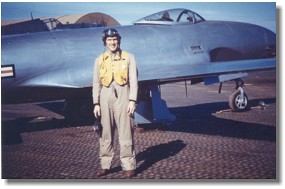 |
The chase pilot followed along giving a verbal talk back, description of the missiles performance and in case it
went astray, it was to be destroyed by gunfire for safety sake. After receiving special training, I, Hersch Pahl,
became the one and only chase pilot and at the same time was the maintenance officer responsible for the up-keep
and manintenace of the two jet aircraft
The Navy did not have jet trained maintenance people yet so the best I had was three good first class
Mechanics, (one following the other with some overlap).
Hersch's P-80 Chase Plane 29689
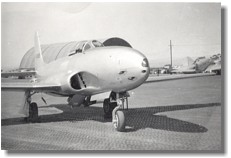 |
To get them some experience with the P-80s I made a verbal deal with some of my Army Air Corps (soon
to become Air Force) friends in the First Fighter Wing at March Field. (I had gone through Jet school with them
at Chandler, AZ). It was agreed that my men would live and work as on the job training, with their maintenance
people and be given the opportunity to learn about jet maintenance checks and techniques, etc.
These (three first class) gents, Cliff Weirick, Mason and Wilson were with the Air Force off and
on for several months during which I looked after them - took their mail, pay and other needed items over to them
(some 150 air miles away), using our F8F Bearcat Fighter plane. Of course when I hauled them back and forth I used
one of our SNB Beachcraft planes.
With the help of a Civilian Tec Rep, Leon Everheart, from Lockheed Aircraft, we managed to take good
care of our two jet planes.
Cliff Weirick refueling Hersch's P-80 29689
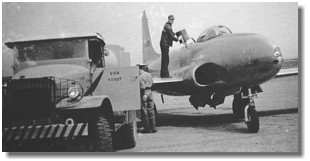 |
The most serious problem that we had in maintaining and operating the jets was dealing with contaminated
fuel that arrived in 55 gal barrels, and out-dated manintenace procedures that were not established for jets. It
was difficult to educate those in the upper echelon of command who made decision for us that were not always in
the best interest of safety. .
We had no problems with the six 50 caliber guns in the nose of the plane as my old friend and former
leading chief from VF-6, Chief "Steve" Piwetz
was there on the job and kept my guns operating. The only trouble we had was that I used a lot of ammunition which
was expensive.
While we were operating i.e. chasing missiles with loaded guns and doing some pretty risky things,
Cliff and my other guys, worried about the P-80 being misused or put unnecessarily in danger. They knew that some
of the things the missile engineers were asking me to do were unsafe and risky, but I assured them that we would
use good judgment.
It came to pass on 13 Nov 1947 while on a chase flight, the missile being tested needed to be destroyed.
It was a fast one, so I had no speed advantage and had to shoot from a dangerous tail-on position. My opening burst
with six 50 caliber guns were direct hits and caused the "bird" to explode. The fireball had no speed
so my plane went through the fireball in an instant. I could not avoid it. There was wreckage, and unburned fuel
in that fire ball plus a 1,000 lb concrete war head.
The blast or shock from the explosion bashed in the side of my plane, the big door that conceals
the guns and ammunition cans....
|
Damage to my P-80B chase plane
was sustained when I flew through an exploded missile fireball
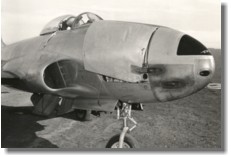 |
|
|
The damage to the gun compartment of my aircraft
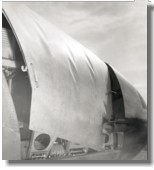 |
|
Click images for Larger View
I gained altitude and slowed the plane down trying to avoid having any more damage done. Soon I was
back on the ground at Mugu with all safety precautions being taken by fire and crash crews. When I first saw Cliff,
he looked at me as if to say "What have you done to my beautiful plane?" The right wing had been so immersed
in unburned fuel that continued to burn on the wing....
The right wing had been so immersed in unburned fuel that
continued to burn on the wing.
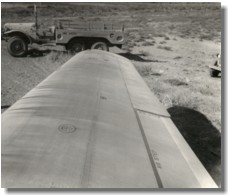 |
Unburned fuel from the exploding missile that I was shooting at, bathed the wing of my aircraft,
(P-80B) and continued to burn, causing the burn streaks on the right wing. This caused no structural damage and
the burn streaks were easily removed.
Another time while trying to take photographs of a fast Air to Air Missile (Lark) the missile was
blown up right in my face and again my plane went shooting through the wreckage and unburned fuel. Again I was
lucky not to contact any big pieces of wreckage; however, this time the rocket fuel happened to be acid and aniline.
By the time I landed and before the fire-fighters could wash the stuff off, some pitting had already occurred in
some places on the skin of the wing. Again, Cliff gave me that look "What have you done to my beautiful plane?"
There was another time when I didn't even come back from the flight right away. The guys thought
the worst. I had chased a wayward bird all the way from Point Mugu north to Moro Bay near where Vandenberg Air
Force base is located today. For economic reasons I had been limited to just a small load of amo, which was not
enough to get the bird shot down so all I could do was chase it and confirm its demise when it ran out of fuel
and crashed in Moro Bay. On the way back, I too, ran low on fuel and had to land at Santa Barbara. After my plane
had been refueled, the return flight to Mugu was uneventful.
Gorgon IV Missile hanging on the wing of a P-61 "Black
Widow" night fighter
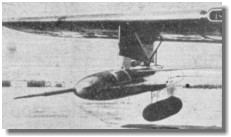 |
The P-80 fighter planes (that Cliff Weirick worried about), were also used to chase a missile known
as Gorgon IV. It was a subsonic ram jet built by Marquardt Aircraft Co.
Hersch Pahl (right) with Gorgon IV Missile hanging on the
wing of a P-61 night fighter, ready for a test flight. At the NAMTC Point Mugu, CA 1947.
 |
For testing it was carried aloft and launched from a P-61 "Black-widow" night fighter...
This too was a dangerous job for the chase pilot. While filming certain events of a scheduled test,
the recovery parachute of the missile opened prematurely in the face or directly in front of the chase plane. Once
again, the Chase Plane and I were very lucky.
P-61 "Black-widow" night fighter
 |
This is a "Lark" Air to Air Missile launched from
Naval Air Missile Test Center, Point Mugu, CA. 1947.
 |
This Air to Air Missile known as the "Lark" was launched from Naval Air Missile Test Center,
Point Mugu, CA. 1947.
In a test conducted to demonstrate the destruct system on
the missile, and while the P-80 chase pilot was attempting to photograph such an event, the missile was blown up
directly in front of the photographing P-80. Both plane and pilot, Pahl, were exposed to dangerous situation. The
aircraft sustained some damage from the unburned acid and aniline propellant, while on the ground, Cliff Weirick
worried about his airplane again.
Note: This photo was borrowed from NAVWEPS 00-80P-1 U S Naval Aviation 1910 -1960.
New and different safety measures were being developed in early '49 so that the missile chase job
was no longer required and was gradually being done away with.
In time Cliff, Wilson and Mason were rotated to other duty stations. Cliff was sent back to sea duty
aboard the USS Kearsarge (CV-33)
for an extended tour of duty while I was sent to school at Monterey, CA.
In about 1985, Cliff discovered a collection of old aircraft that had been accumulated by a couple
in Ohio and checked it out to find the remains of our old friend P-80A, 29689...
|
Hersch's P-80 Chase Plane 29689 which Cliff found in an Ohio
junk yard which was part of the It was a part of the Soplata aircraft Collection - still bearing '689'
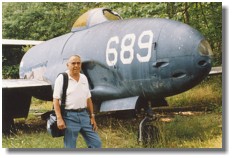 |
|
|
Hersch's Chase plane still bears the "Point Mugu"
tail identifier
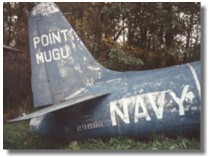 |
|
I don't know just how he did it but he was partly responsible for making a deal with the Army museum
at Indianapolis to refurbish and return it to flyable condition. They could not find a usable jet engine, so they
could not fly it, but they cleaned the old plane up and made a beautiful shinny museum piece out of it.
That old plane became the property of a dealer in Atlanta and then he traded it to the Navy where
it went on display in the Naval Air Museum in Pensacola, Fla.
In the '90s after Cliff had been over taken by poor health, Bonnie and I visited the Museum in Pensacola
and paid my respects to that "grand ol' gal" which still looked pretty good.. Sadly though, the Navy
was at that time preparing to trade it to an Air Force Museum. It seems the U.S. Air Force didn't have a P-80A
or one of that vintage, manufactured in 1946.
|
P-80 29689, which was used by Pahl at Point Mugu to chase missiles--
it is now on display at the Navy's Air Museum in Pensacola, FL
|
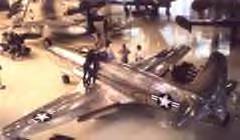
|
|
|
P-80 29689, which was used by Pahl at Point Mugu to chase
missiles-- it is now on display at the Navy's Air Museum in Pensacola, FL
|
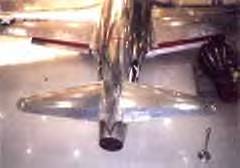
|
|
Click images for Larger View
Before Cliff gave up his hunt, he located the other P-80B
29690 which was being used as a static display at Holloman Air Force Base, New Mexico.
Hersch Pahl with P-80B Chase Plane
#29690
Information on the P-80 is here
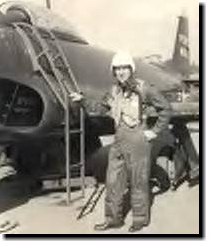 |
Since that time in about 1995, my wife, Bonnie and I stopped
by at Holloman AFB and paid our respects to another old Friend, my old P-80B, 29690 which was on Static display
just inside the entrance...
My 'Old Friend' - P-80B #29690 at Holloman AFB
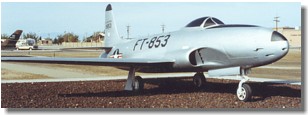 |
As the years went by we lost track of each other until about 1990 after we both had retired from
the Navy. By that time Cliff had followed his hobby of building and flying model airplanes and had become an authority
in officiating Radio controlled model flying meets. He had also started building real airplanes at his home in
Oceanside, CA. I didn't pay much attention, but soon I learned that he was flying his own planes that he had constructed
himself.
In the summer 1993 we managed to meet at the airport in Redlands near where I was visiting my brother,
Harold.
Cliff flew this "Fox Cart" aircraft from his home
in Oceanside, CA to Redlands for a renewal of an old friendship - a friendship which began from our days at Point
Mugu twenty six years earlier. Cliff built this snappy little plane by himself.
Cliff Weirick left and Hersch Pahl
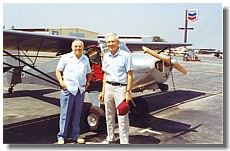 |
That same day...
Hersch (L) and brother, Harold Pahl
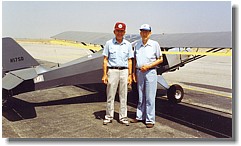 |
Hersch and his brother, Harold Pahl pose with Cliff's "Fox-cart" home build aircraft at
the Redlands Airport summer 1993. (Cliff was the photographer.)
Cliff also proudly showed us photos and told us about the one half scale F4U fighter plane he had
built and flown by himself.. The real clincher was the occasion when a real F4U-4 joined up and flew wing on him
in his ½ scale F4U... what a thrill that must have been!
F4U-4 Corsar flying in formation with a half scale model of
a F4U Corsair designed
and built by Cliff Weirick, Hersch's P-80 plane captain at Point Mugu
|
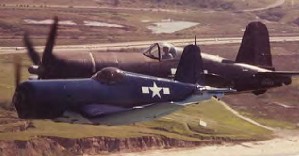
|
See more Photos of Cliff's Hobby Planes below

Cliff, I will never forget you for your outstanding technical
know-how, and unlimited enthusiasm and enjoyment that kept you going with airplanes. That enthusiasm and your dedicated
service was also very important in keeping me going too Thanks, Cliff!
Sadly it must be added that Cliff succumbed to a massive
stroke Christmas day 2001 and passed on
April 2002, to be with his old
buddies and perhaps an old plane or two.
- Hersch Pahl

Photos of Cliff Weirick's Hobby Planes
and Models
Cliff's Home-built 1/2 scale F4U-4 Corsair
is under construction
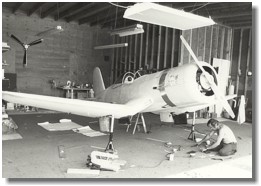 |
In regard to the above aircraft that Cliff Weirick built
-In a letter to me on Nov 27 1990, Cliff wrote "The 'Corsair' is a one half size wood frame with foam to give
it shape. It is covered with two layers of fiber glass and powered by a Lycoming 0-235 -115 hp. engine. Trued out
at 160 mph., it was a joy to fly. I worked at Palomar Airport for a short period and worked (maintenance) on this
big F4U Corsair there. One day we both got in the air at the same time. We did some formation flying and had our
picture taken. Great fun!! I finally sold it about three years ago after flying it for 3 years and 163 hours. Later
I understand that it ended up mounted in the play yard at a school down south some where for kids to play on.
Cliff's flies his home-built half scale F4U-4 Corsair
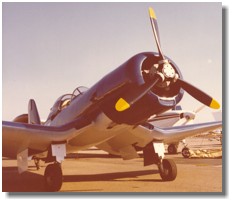 |
Cliff' taxiing his half scale F4U-4 Corsair
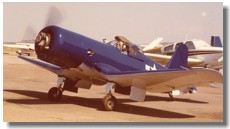 |
Cliff's Home-built half scale F4U-4 Corsair
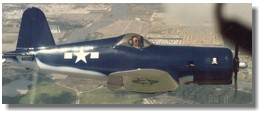 |
Cliff's flies his home-built half scale F4U-4 Corsair in the
skies over Southern California.
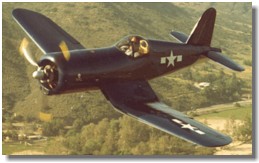 |
Cliff Weirick became involved in constructing radio controlled
model aircraft. He also designed and constructed a radio controlled model of his ship, the USS Kearsarge, (CV-33).
He received approving applauds from his former ship mates at a reunion in San Diego, when he launched it and demonstrated
short cruise capability in a swimming pool...
Cliff Weirick made a radio-controlled 5 foot model of the
USS Kearsarge (CV-33)
 |
Cliff Weirick made a radio-controlled 5 foot model of the
USS Kearsarge (CV-33) and shown it in a Swimming Pool at a San Diego USS Kearsarge (CV-33) Reunion.
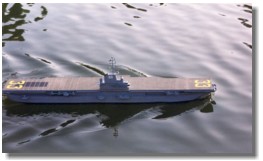 |
Cliff's shows his model of the USS Kearsarge (CV-33) at a
San Diego Reunion
 |
"For those who fought for it...
freedom has a flavor the protected will never know!"
|